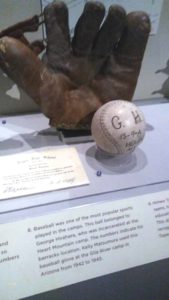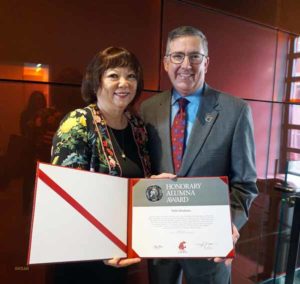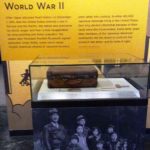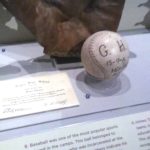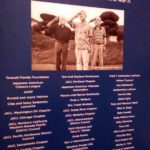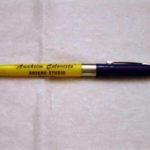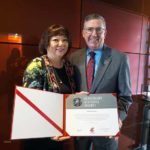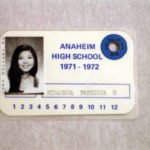Sharing Her Family’s Unique History Becomes Life Work for AHS Alumna
Anaheim High Class of 1973 graduate Patti Hirahara, whose family came to Anaheim as part of the Japanese-American resettlement after WWII, is carrying her family’s story forward by sharing an acclaimed photo collection and other ephemerae preserved from their incarceration in a WWII Japanese relocation camp.
Her work is also helping illuminate Anaheim High’s connection to the Japanese-American WWII experience.
Patti’s father, grandparents and great-grandparents were moved from Yakima, Washington, to Wyoming’s Heart Mountain Relocation Center. From a secret darkroom underneath a camp barracks, Patti’s father, Frank, and grandfather, George, developed and printed 2000 photographs that chronicled the lives of the 10,000-population Heart Mountain camp.
(There were nine other camps built under the direction of President Franklin D. Roosevelt’s Executive Order 9066, which authorized the incarceration of 120,000 Japanese-Americans, including infants and children. Over two-thirds of them were U.S. citizens. Signed Feb. 19, 1942, the order was later called America’s “worst wartime mistake.”)
As a citizen of Japan, her grandfather George was not allowed to possess camera equipment. But Patti’s father Frank C. Hirahara, then a high school teenager, was a U.S. citizen and allowed to take photos with the family camera purchased from the Sears, Roebuck and Montgomery Ward catalogs.
While Frank was incarcerated, he played trumpet in the famous Heart Mountain George Igawa Dance Band and was photo editor of the Heart Mountain High School “Tempo” annual during his senior year in 1944.
When Frank passed away in 2006, he could not have imagined that his family’s history would allow historians and museums to create photographic collections and exhibits across the U.S. that would tell the tale of the Japanese immigration into the United States, their history in America, and the incarceration of Japanese Americans during WWII.
Thanks to Patti’s diligence, her ancestors’ experience became the subject of an Emmy-award winning documentary, “The Legacy of Heart Mountain,” and used as background historical material for the world premiere of the musical “Allegiance” at the Old Globe Theater in San Diego.
In addition, the family’s photo collection has been displayed in numerous exhibits, including being shown at the Smithsonian’s National Museum of American History and the FDR Presidential Library and Museum.
After he was released from the camp in 1945, he continued his education at Washington State University, where he earned a bachelor’s degree in electrical engineering in 1948.
In 2010, Patti donated the original negatives and photos to WSU. Funding from the National Park Service’s Japanese American Confinement Sites Grant Program allowed the University to preserve, clean and digitize the negatives for future generations. Click this link to access the collection.
For her work, Patti has received numerous awards and recognitions, including being named a WSU honorary alumna. Receiving the award was especially significant for her, as this year marks the 75th anniversary of when her father began taking photos in the camp.
“WSU’s history is unknown to many people, especially the fact that the university allowed Japanese-American students to continue their education during WWII,” she said. “It is an extreme honor to be recognized by my father’s alma mater and it has been a wonderful partnership with WSU over the last eight years.” She is the first Japanese American to receive the award since 1966.
Patti has worked more than six years locating many of the people in the photos. By sharing them with family descendants, she offered them a piece of history that they never knew existed. In addition, she’s spearheaded workshops, films and presentations during which she shared her family’s story and photo collection with hundreds of students and community members, as well as being a featured speaker at the FDR Presidential Library.
In 2009, the Anaheim Library’s Heritage Center held its first museum without walls exhibit documenting the Hirahara family’s legacy to the City.
Most recently, Patti’s has joined efforts with the Anaheim Library Heritage Center to identify and interview the 50 students of Japanese descent whose educations at Anaheim High were interruped when their families were forced to relocate to camps.
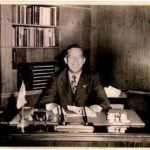 A particularly poignant part of the Anaheim High story is that the principal at this time, Dr. Paul Demaree, was born in Japan to missionary parents. He was especially vocal in speaking out against discrimination toward Japanese-Americans, a courageous position to take considering the war fervor at the time. Principal Demaree, who also served as the District’s superintendent, kept in touch with his Japanese-American students and encouraged them to continue their studies.
A particularly poignant part of the Anaheim High story is that the principal at this time, Dr. Paul Demaree, was born in Japan to missionary parents. He was especially vocal in speaking out against discrimination toward Japanese-Americans, a courageous position to take considering the war fervor at the time. Principal Demaree, who also served as the District’s superintendent, kept in touch with his Japanese-American students and encouraged them to continue their studies.
Ironically, the parents of today’s AUHSD Superintendent, Mike Matsuda, were both incarcerated in the same internment camp; his mother, Ruth Ikeda, was one of the students who had to leave Anaheim High during her freshman year.
- Smithsonian Exhibit at American History Museum
- Hirahara photos part of exhibit.
- George Hirahara’s softball seen at Smithsonian during AHSAA visit.
- Hirahara Family contributes to Smithsonian exhibit.
- Anaheim High connection to Japanese-American WWII experience
- Part of Patti’s Anaheim memorabilia collection
- Patti donated her family’s photo collection to Washington State University
- Patti Hirahara named honorary WSU alumna
- Patti graduated from AHS in 1973.
- AHS Student Body Card
- Patti’s school memorabilia was displayed in the Anaheim Heritage Center.
- Patti at Anaheim High
